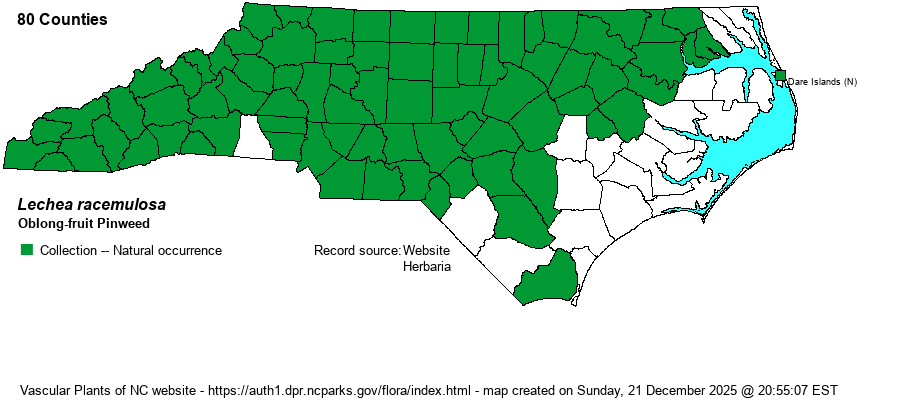| Author | Michaux | |
| Distribution | Throughout the Mountains and Piedmont; generally throughout the western half of the Coastal Plain, but mostly absent from the eastern portions.
This is an Eastern species, ranging from NY and IA south to central GA and AL.
| |
| Abundance | Common across the Mountains and Piedmont; fairly common to common in the western Coastal Plain, but very rare to absent in the eastern counties, though there are a few scattered records in this part of the state. This is essentially the only Lechea species in the Mountains and far western Piedmont, with a few others tending to be rare in these regions. | |
| Habitat | This is a species of dry places, usually in dry clay soils. It grows in old fields, wooded margins, powerline clearings, and in other clearings. | |
| Phenology | Blooms in June and July, and fruits from July to October. | |
| Identification | This is mostly the default Lechea of the mountains and western Piedmont, but in the eastern two-thirds of the Piedmont it must be separated from L. tenuifolia, and in the western half of the Coastal Plain a number of other species are present for potential confusion. It is a rather small pinweed, growing only to about 8-12 inches tall, with numerous spreading/ascending branches. As with most others, it has the stem with mostly appressed hairs. The basal shoots have very small whorled leaves, elliptical but only about 1/5-inch long. The leaves on the stem and branches are longer, about 1/2-inch long, and somewhat linear to narrowly elliptical. The tiny flowers are in small clusters near the branch tips, with the pedicels 1-4 mm long (at least somewhat visible). Visually the species looks quite like a few others, such as L. minor. The species is best identified by geography, by the pedicels longer than the fruit, and especially in the pyriform (pear-shaped) capsules, as opposed to somewhat ovoid to globose in other species. Technically, the "Base of the fruiting calyx clearly differentiated into a hardened, shiny, yellowish, obconic base 0.4-0.6 mm long, contrasting in color and texture with the rest of the calyx" (Weakley 2018). Obviously, this is a character seen with a hand lens or under a microscope. | |
| Taxonomic Comments | None
| |
| Other Common Name(s) | Illinois Pinweed, Appalachian Pinweed, Racemose Pinweed, Common Pinweed. Most references name this -- erroneously -- as Illinois Pinweed. It occurs in 19 states in the US -- including OH, IN, IA, and MO -- yet it does not occur in Illinois! Thus the editors are choosing a different common name, something not normally done on this site. A few websites use Oblong-fruit or Oblong-fruited as the modifier name, and Weakley uses Appalachian as a modifier name. | |
| State Rank | S5 | |
| Global Rank | G5 | |
| State Status | | |
| US Status | | |
| USACE-agcp | | |
| USACE-emp | | |

